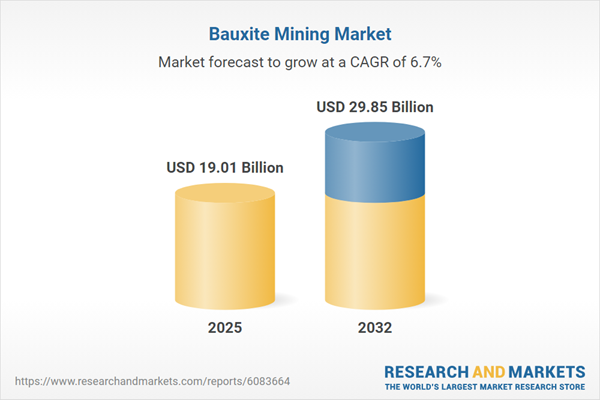Speak directly to the analyst to clarify any post sales queries you may have.
The bauxite mining market is undergoing rapid transformation as it adapts to supply chain complexities, regulatory shifts, and intensifying competition. Senior executives require data-driven intelligence to effectively steer business strategies and capture emerging value across this evolving industry.
Market Snapshot: Bauxite Mining Market Growth and Trajectory
The global bauxite mining market expanded from USD 17.83 billion in 2024 to USD 19.01 billion in 2025 and is projected to maintain a compound annual growth rate (CAGR) of 6.65%, reaching USD 29.85 billion by 2032.
Market growth is being driven by rising aluminum demand, innovations in extraction and refining technology, and increasingly integral sustainability practices. Companies are evolving operational models to address new trade regulations, variable raw material supply, and ongoing changes in trade routes, which are together influencing global production flows and the bauxite supply chain.Scope & Segmentation of the Bauxite Mining Market
This report provides a comprehensive framework for senior leaders seeking clear performance benchmarks and identification of emerging opportunities. The analysis spans all key sectors, operational innovations, and global regions critical for competitive positioning.
- End-Use Industry: Includes aluminum production (primary and secondary smelting), the cement industry (notably Portland cement), and refractory products such as bricks and monolithics. These sectors shape extraction intensity and define the broader value chain.
- Process Type: Reviews both open pit and underground mining for operational efficiency, adaptability, and environmental considerations in different geological settings.
- Product Type: Encompasses cement grade (brown fused alumina, calcined alumina), chemical grade (activated and adsorbent alumina), and metallurgical grade (boehmite, diaspore, gibbsite), each impacting downstream optimization and customer alignment.
- Distribution Channel: Assesses direct purchase, established distribution networks, offline trade channels, and the rise of online procurement platforms, all of which influence market reach and procurement strategy.
- Regional Coverage: Details market trends and regulatory landscapes across the Americas (including US, Canada, Mexico, Brazil, Argentina, Chile, Colombia, Peru), Europe, Middle East & Africa (including the UK, Germany, France, Russia, Italy, Spain, Netherlands, Sweden, Poland, Switzerland, UAE, Saudi Arabia, Qatar, Turkey, Israel, South Africa, Nigeria, Egypt, Kenya), and Asia-Pacific (China, India, Japan, Australia, South Korea, Indonesia, Thailand, Malaysia, Singapore, Taiwan). This broad view enables the adjustment of localization strategies in response to differing regulatory frameworks and demand patterns.
- Companies Profiled: Offers in-depth perspectives on Compagnie des Bauxites de Guinée, Rio Tinto plc, Alcoa Corporation, Vale S.A., Norsk Hydro ASA, United Company RUSAL International PJSC, South32 Limited, Aluminum Corporation of China Limited, National Aluminium Company Limited, and Hindalco Industries Limited, to aid benchmarking and competitive assessment.
Bauxite Mining Market: Key Takeaways for Senior Decision-Makers
- Technological innovation is enhancing extraction and refining processes, using real-time automation, digital twins, and advanced analytics for improved efficiency and flexibility.
- Adoption of sustainability practices is gaining pace, with renewable energy integration, water recycling, and low-emission solutions now part of mainstream operations and the supply chain.
- Executives must navigate complex regulatory environments where proactive compliance ensures both long-term viability and reduced operational risk across key jurisdictions.
- Operational standards set by Asia-Pacific economies are becoming industry benchmarks, spurred by local policy support and major industrial investment focused on value addition and upgrading technology.
- Strategic engagement with government and local communities is essential to secure resource rights and ensure stable operations, particularly in the face of increased land competition and evolving societal expectations.
- Diversification into advanced alumina grades and differentiated end-use segments supports premium pricing and closer alignment with evolving client needs in cement, chemical, and metallurgical markets.
Impact of United States Tariff Policies on Market Dynamics
Shifts in US tariff regulations have reshaped global bauxite trading flows, prompting buyers to seek out tariff-exempt alternatives. Competition among exporting nations has intensified, driving investment in local processing and reducing dependence on volatile external markets. Executives are revising supply chain contracts, exploring new offtake agreements outside US-led routes, and refocusing logistics structures to ensure operational continuity amid regulatory change.
Research Methodology & Data Sources
This report integrates credible secondary sources—technical whitepapers, regulatory filings, and academic research—with expert interviews involving mining industry leaders, metallurgists, and operational managers. Trade data validation and logistics analysis reinforce accuracy, while peer reviews and sensitivity analysis confirm reliability.
Why This Report Matters to Industry Leaders
- Empowers executive teams with actionable insights to uncover strategic opportunities and drive impactful investment decisions within primary market segments.
- Delivers a framework for proactive risk management in fast-changing regulatory and tariff landscapes, ensuring organizational agility and compliance.
- Supports benchmarking for resilient supply chains and accelerated adoption of sustainability-focused practices across international operations.
Conclusion
This report equips industry leaders with strategic intelligence to guide sustainable growth and build competitive advantage in the transforming bauxite mining sector. Decision-makers gain the clarity needed to align operations with new industry standards and stakeholder expectations.
Table of Contents
3. Executive Summary
4. Market Overview
7. Cumulative Impact of Artificial Intelligence 2025
Companies Mentioned
The companies profiled in this Bauxite Mining market report include:- Compagnie des Bauxites de Guinée
- Rio Tinto plc
- Alcoa Corporation
- Vale S.A.
- Norsk Hydro ASA
- United Company RUSAL International PJSC
- South32 Limited
- Aluminum Corporation of China Limited
- National Aluminium Company Limited
- Hindalco Industries Limited
Table Information
| Report Attribute | Details |
|---|---|
| No. of Pages | 185 |
| Published | November 2025 |
| Forecast Period | 2025 - 2032 |
| Estimated Market Value ( USD | $ 19.01 Billion |
| Forecasted Market Value ( USD | $ 29.85 Billion |
| Compound Annual Growth Rate | 6.6% |
| Regions Covered | Global |
| No. of Companies Mentioned | 11 |









